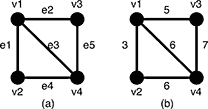POJ-3522 Slim Span(最小生成树)
| Time Limit: 5000MS | Memory Limit: 65536K | |
| Total Submissions: 8633 | Accepted: 4608 |
Description
Given an undirected weighted graph G, you should find one of spanning trees specified as follows.
The graph G is an ordered pair (V, E), where V is a set of vertices {v1, v2, …, vn} and E is a set of undirected edges {e1, e2, …, em}. Each edge e ∈ E has its weight w(e).
A spanning tree T is a tree (a connected subgraph without cycles) which connects all the n vertices with n − 1 edges. The slimness of a spanning tree T is defined as the difference between the largest weight and the smallest weight among the n − 1 edges of T.

Figure 5: A graph G and the weights of the edges
For example, a graph G in Figure 5(a) has four vertices {v1, v2, v3, v4} and five undirected edges {e1, e2, e3, e4, e5}. The weights of the edges are w(e1) = 3, w(e2) = 5, w(e3) = 6, w(e4) = 6, w(e5) = 7 as shown in Figure 5(b).

Figure 6: Examples of the spanning trees of G
There are several spanning trees for G. Four of them are depicted in Figure 6(a)~(d). The spanning tree Ta in Figure 6(a) has three edges whose weights are 3, 6 and 7. The largest weight is 7 and the smallest weight is 3 so that the slimness of the tree Ta is 4. The slimnesses of spanning trees Tb, Tc and Td shown in Figure 6(b), (c) and (d) are 3, 2 and 1, respectively. You can easily see the slimness of any other spanning tree is greater than or equal to 1, thus the spanning tree Td in Figure 6(d) is one of the slimmest spanning trees whose slimness is 1.
Your job is to write a program that computes the smallest slimness.
Input
The input consists of multiple datasets, followed by a line containing two zeros separated by a space. Each dataset has the following format.
| n | m | |
| a1 | b1 | w1 |
| ⋮ | ||
| am | bm | wm |
Every input item in a dataset is a non-negative integer. Items in a line are separated by a space. n is the number of the vertices and m the number of the edges. You can assume 2 ≤ n ≤ 100 and 0 ≤ m ≤ n(n − 1)/2. ak and bk (k = 1, …, m) are positive integers less than or equal to n, which represent the two vertices vak and vbk connected by the kth edge ek. wk is a positive integer less than or equal to 10000, which indicates the weight of ek. You can assume that the graph G = (V, E) is simple, that is, there are no self-loops (that connect the same vertex) nor parallel edges (that are two or more edges whose both ends are the same two vertices).
Output
For each dataset, if the graph has spanning trees, the smallest slimness among them should be printed. Otherwise, −1 should be printed. An output should not contain extra characters.
Sample Input
4 5
1 2 3
1 3 5
1 4 6
2 4 6
3 4 7
4 6
1 2 10
1 3 100
1 4 90
2 3 20
2 4 80
3 4 40
2 1
1 2 1
3 0
3 1
1 2 1
3 3
1 2 2
2 3 5
1 3 6
5 10
1 2 110
1 3 120
1 4 130
1 5 120
2 3 110
2 4 120
2 5 130
3 4 120
3 5 110
4 5 120
5 10
1 2 9384
1 3 887
1 4 2778
1 5 6916
2 3 7794
2 4 8336
2 5 5387
3 4 493
3 5 6650
4 5 1422
5 8
1 2 1
2 3 100
3 4 100
4 5 100
1 5 50
2 5 50
3 5 50
4 1 150
0 0
Sample Output
1
20
0
-1
-1
1
0
1686
50
Source
#include<cstdio>
#include<cstring>
#include<algorithm>
using namespace std;
const int INF=0x3f3f3f3f;
const int maxn=;
int f[];
int n,m;
struct Edge
{
int u,v,w;
};
Edge edge[]; bool cmp(Edge a,Edge b)
{
return a.w<b.w;
} int Find(int x)
{
int r = x;
while(r!=f[r])
{
r = f[r];
}
while(x!=f[x])
{
int j = f[x];
f[x] = f[r];
x = j;
}
return x;
} void merge2(int x,int y)
{
int fx=Find(x);
int fy=Find(y);
if(fx!=fy)
{
f[fy] = fx;
}
} int Cal(int x)
{
int i;
for(i=;i<=n;i++)
{
f[i] = i;
}
int mind=INF,maxd=-;
int cnt=;
for(i=x;i<m;i++)
{
int u=edge[i].u , v=edge[i].v , w=edge[i].w;
int fu=Find(u),fv=Find(v);
if(fu!=fv)
{
f[fu] = fv;
cnt++;
mind = min(mind,w);
maxd = max(maxd,w);
merge2(u,v);
}
if(cnt==n-)
break;
}
if(cnt == n-)
{
int ans = maxd-mind;
return ans;
}
return -;
} int main()
{
while(scanf("%d %d",&n,&m)!=EOF)
{
if(n==&&m==)
{
break;
}
int i,a,b,w;
for(i=;i<m;i++)
{
scanf("%d %d %d",&a,&b,&w);
edge[i].u=a;
edge[i].v=b;
edge[i].w=w;
}
sort(edge,edge+m,cmp);
int ans=INF;
for(i=;i<m;i++)
{
if(m-i<n-)
{
break;
}
int d = Cal(i);
if(d!=- && d<ans)
{
ans = d;
}
}
if(ans == INF)
printf("-1\n");
else
printf("%d\n",ans);
}
}
最新文章
- oracle查看对象信息
- 关于ScheduledExecutorService执行一段时间之后就不执行的问题
- 读取Excel文件
- 无法访问 IIS 元数据库。您没有足够的特权访问计算机上的 IIS 网站
- LightOJ1005 Rooks(DP/排列组合)
- [HDF]hdf-4.2.6类库的使用
- (转)Android L Ripple的使用
- selenium修改控件属性
- java常用重构优化总结--自己亲身体验
- linux内核--内存管理(二)
- PyQt设计流程
- div盒子水平垂直居中的方法
- 移动开发 meta元素
- Hive总结(七)Hive四种数据导入方式
- Win10启动tomcat控制台乱码解决方案
- laravel 对接 UCenter 基础
- 3 第一个Django应用 第2部分(管理站点)
- MVC 带扩展名的路由无法访问
- visual studio中新建和使用dll
- HTTPS演变小图